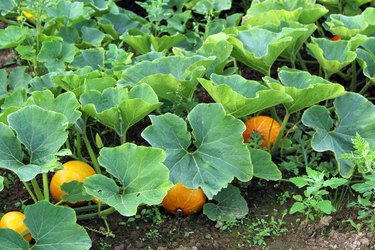
The unusual pumpkin-shaped fruits amid their thorny purple stems are an unusual addition to dried-flower arrangements in fall. Surprisingly, the pumpkin tree plant (Solanum integrifolium) is actually a close relative of the eggplant (Solanum melongena). You can enjoy the fruits in stir-fries while still green or wait until the fruits turn bright orange-red and harvest the entire stem to dry for Halloween and Thanksgiving decorations.
About the Pumpkin Tree Plant
Video of the Day
The pumpkin tree plant, also known as pumpkin bush, pumpkin on a stick and scarlet Chinese eggplant, is often grown as an ornamental. Native to Southeast Asia, this annual heirloom produces 2- to 5-inch-wide orange to red ribbed fruits on 3- to 4-foot-tall thorny purple and green stems. The large, fuzzy leaves also sport vertical spikes of purple thorns along their purple veins. While insects will gnaw on the leaves, deer and rabbits avoid its thorny foliage.
Video of the Day
How to Grow a Pumpkin Tree
Like other members of the Solanum family, pumpkin tree plants thrive in the warm summer garden. Start seeds indoors for a head start on the season six weeks before the last frost date. Plant the seeds 1/4 to 1/2 inch deep in moist seed-starting mix. Place the seed-starting tray on a seed-heat mat and cover it with a clear lid or plastic wrap.
At 70 to 85 degrees Fahrenheit, the seeds will germinate in 10 to 14 days. Remove the cover when the seedlings appear and place them in bright, filtered light for 14 hours daily. Use a grow light or fluorescent light over the seedlings to provide adequate light. Always wear gloves when working around your pumpkin tree plants to prevent puncture wounds.
Prepare a sunny, well-drained garden bed by digging in 2 to 3 inches of compost. Dig the planting holes 3 feet apart and then fill them with water and allow them to drain before planting the seedlings at the same depth as they were in the seed-starting tray or pots. Add a tomato cage or stakes to support the plants and fruits as they grow. Water when the soil is dry to a depth of 1 inch and fertilize with a slow-release fertilizer formulated for tomatoes according to the package directions.
Harvest the Fruits for Cooking
Harvest the pumpkin tree fruits when they reach their mature size but are still green. The outer skin becomes shiny. While the green fruits have a mild flavor, if you wait until they ripen to red, they develop a bitter flavor that makes them less than palatable. Put on thornproof gloves and snip the fruits from the stems with sterilized pruners.
You can use pumpkin tree fruits in any recipe that calls for eggplant or in a simple stir-fry. Wash and then slice or chop the green fruits, onions, garlic cloves and any other vegetables you may want to add to the stir-fry. Sauté the onions and garlic in a tablespoon of olive oil over medium-high heat and then add the pumpkin tree fruits and other vegetables. Cook until tender, stirring regularly to prevent sticking.
Dry Pumpkin Tree Fruits
Leave the fruits on the stems until they turn bright orange-red. Put on gloves and then cut the stems near the base of the plants. Hang the stems upside down in a dry location with good air circulation until the fruits, leaves and stems are dry. Remove the dead leaves and thorns and then use them in dry arrangements for Halloween or Thanksgiving. While the fruits are not toxic, they are very bitter, so keep them out of the reach of children and pets.